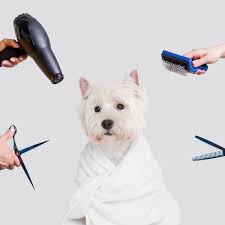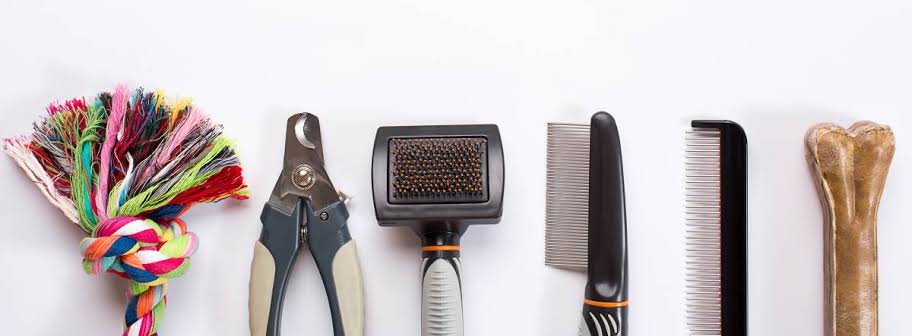
The Ultimate Guide to the Best Pet Grooming Tools for At-Home Care: Grooming your pet at home isn’t just a way to save money it’s also a fantastic bonding experience and a vital part of keeping your furry friend healthy, happy, and looking great. With the right tools and techniques, you can transform your home into a mini grooming salon.

In this guide, we’ll explore the best pet grooming tools for dogs and cats, why they matter, how to use them, and how to choose what’s right for your pet’s coat, size, and temperament.
Why Grooming Matters
Pet grooming is more than a luxury it’s essential for:
- Skin and coat health
- Early detection of lumps or parasites
- Odor control
- Shedding and matting prevention
- Overall comfort and hygiene
Whether you have a short-haired Beagle or a long-haired Persian cat, regular grooming keeps them looking and feeling their best.
Core Categories of At-Home Grooming Tools
Let’s break it down into key grooming tool categories and recommend the best tools in each.
1. Brushes and Combs
Choosing the right brush depends on your pet’s coat type. You may need more than one tool.
a. Slicker Brushes
- Best for: Long-haired dogs and cats (Golden Retrievers, Collies, Persians)
- Purpose: Removes mats, tangles, loose fur
- Top Pick: Hertzko Self-Cleaning Slicker Brush
- Fine, bent wires reach deep without scratching skin
- Retractable bristles make cleaning easy
b. Bristle Brushes
- Best for: Short-haired breeds (Pugs, Boxers)
- Purpose: Removes debris and distributes natural oils
- Top Pick: KONG ZoomGroom
- Doubles as a massager
- Gentle on skin and great for bathing
c. Undercoat Rakes & Deshedding Tools
- Best for: Double-coated breeds (Huskies, Labs)
- Purpose: Removes dead undercoat to reduce shedding
- Top Pick: FURminator Undercoat Deshedding Tool
- Stainless steel edge penetrates topcoat safely
- Reduces shedding up to 90%
d. Flea Combs
- Best for: All breeds during flea season
- Purpose: Detects and removes fleas, eggs, and dirt
- Top Pick: Safari Flea Comb
- Fine teeth catch fleas without irritating the skin
2. Clippers and Scissors
Some breeds (Poodles, Shih Tzus, Doodles) require regular trimming. Clippers and scissors give you salon-style control at home.
a. Pet Clippers
- Best for: Medium to long-haired breeds that need trimming
- Top Pick: Andis ProClip AGC2 2-Speed Clipper
- Quiet motor, detachable blades, professional-grade
- Alternative: Oneisall Low Noise Cordless Clippers (great for nervous pets)
b. Grooming Scissors
- Best for: Finishing work around the face, paws, ears
- Top Pick: Pet Magasin Grooming Scissors Kit
- Rounded tips for safety
- Ergonomic grip
3. Shampoos and Conditioners
A good bath keeps your pet smelling fresh and prevents skin problems. Always use pet-formulated shampoos (human shampoo is too harsh).
a. General Purpose Shampoos
- Top Pick: Earthbath Oatmeal & Aloe Shampoo
- Natural, soap-free, gentle on sensitive skin
b. Medicated Shampoos
- Best for: Pets with dermatitis, allergies, or dandruff
- Top Pick: Veterinary Formula Clinical Care Shampoo
c. Waterless Shampoos
- Great for: Quick cleanups or pets who hate water
- Top Pick: Burt’s Bees Waterless Shampoo Spray
4. Nail Trimming Tools
Trimming nails every 3–6 weeks prevents joint pain and injuries.
a. Nail Clippers
- Top Pick: Safari Professional Nail Trimmer
- Sharp blades, safety stop
b. Nail Grinders
- Best for: Smoother finish, fearful pets
- Top Pick: Dremel 7300-PT Pet Nail Grinder
- Rechargeable, gentle sanding
5. Dental Care Tools
Oral hygiene is often neglected but crucial. Dental disease can lead to organ damage in pets.
a. Toothbrush and Toothpaste
- Top Pick: Virbac C.E.T. Enzymatic Toothpaste and Dual-Ended Brush
- Safe if swallowed, great taste for pets
b. Dental Wipes
- Alternative for squirmy pets
- Top Pick: Vet’s Best Dental Wipes
READ ALSO: How to Keep Your Dog Active During the Winter Months
6. Ear and Eye Care Tools
Regular checks prevent infections, especially in floppy-eared breeds.
a. Ear Cleaners
- Top Pick: Zymox Ear Solution
- With hydrocortisone for itchy ears
b. Eye Wipes
- Top Pick: Angels’ Eyes Gentle Tear Stain Wipes
- For removing tear stains around the eyes
7. Grooming Tables and Restraints
If you groom regularly, invest in a grooming table for better ergonomics and control.
a. Folding Grooming Table
- Top Pick: Go Pet Club Grooming Table with Arm
- Non-slip surface, adjustable arm
b. Grooming Hammock for Small Dogs
- Best for: Restraint during nail trimming or paw work
- Top Pick: Grooming Sling Hammock Harness
8. Dryers and Towels
Don’t rely on human hairdryers—they’re too hot. Use pet dryers or microfiber towels.
a. Dog Hair Dryer
- Top Pick: B-Air Fido Max 1 Dog Dryer
- No heat, adjustable speed
b. Absorbent Towels
- Top Pick: Soggy Doggy Super Shammy
- Quick-drying microfiber
9. Storage and Kits
Keep everything organized in one place.
a. Grooming Tool Organizer
- Top Pick: Rubbermaid Caddy or Wall-Mounted Organizer
b. Complete Grooming Kits
- Top Pick: Pet Union Professional Dog Grooming Kit
- Includes clippers, scissors, nail trimmers, combs
Pro Tips for Home Grooming Success
- Start young: Acclimate pets early to grooming tools.
- Keep sessions short: Especially for anxious animals.
- Use treats and praise: Make it a positive experience.
- Check for injuries or changes: Grooming time is health-check time.
- Clean tools after each use: Prevents bacteria and tool wear.
FAQs
How often should I groom my pet?
It depends on breed and coat:
- Short-haired pets: Brush weekly, bathe every 2–3 months
- Long-haired pets: Brush daily, bathe monthly
- Nail trimming: Every 3–6 weeks
Can I use human shampoo on my dog or cat?
No. Human shampoos can disrupt the pH balance of your pet’s skin, leading to irritation or dryness. Use a pet-specific, pH-balanced formula.
What’s the best brush for shedding?
The FURminator Deshedding Tool is the gold standard. It removes dead undercoat hair safely and drastically reduces shedding.
Are pet clippers safe for beginners?
Yes, many clippers like Oneisall or Wahl Pet Pro are designed for home use with safety guards and low-noise motors. Always go slowly and avoid sensitive areas.
How do I keep my pet calm during grooming?
- Start with short sessions
- Use calming treats or sprays
- Groom after exercise when they’re tired
- Play soothing music
- Use a grooming hammock for small pets
Can I use baby wipes for pets?
Only if they’re fragrance-free, hypoallergenic, and alcohol-free. But it’s better to use pet-specific wipes to avoid skin irritation.
How do I know if I’ve trimmed the nails too short?
If you see bleeding, you’ve hit the quick. Use a styptic powder like Kwik Stop to stop bleeding. Trim small amounts regularly to avoid this.
Do indoor cats need grooming?
Yes! Indoor cats still shed and can get mats, especially long-haired breeds like Maine Coons or Ragdolls. Weekly brushing is ideal.
Are grooming tables worth it?
If you groom often or have a large dog, yes. Grooming tables improve posture, safety, and efficiency. They’re especially helpful for trimming or drying.
Is grooming stressful for pets?
Not if done correctly. When introduced slowly and positively, grooming becomes a calming ritual. Always reward your pet after a session.
Leave a Reply
You must be logged in to post a comment.